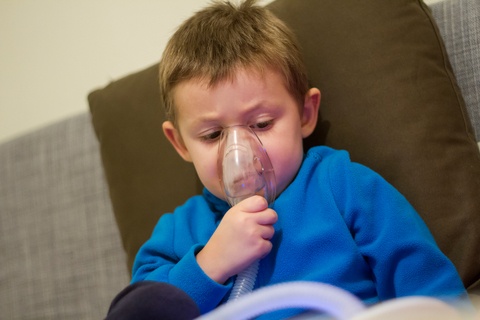Pediatric Asthma - Dubai Pediatric Clinic
- Asthma is reversible obstruction of long and small airway as a result of hyper responsiveness to various stimuli. The disease is intermittent and characterized by recurrent episodes of cough, chest tightness, dyspnea and wheezing. 80% of asthmatic child has first episode by 4 or 5 years of age.
CLINICAL MANIFESTATION
- Wheezing, cough, dyspnea, tachypnea and chest pain during acute exacerbation but are late signs of asthma.
- A history of persistent cough, night cough, exercises induced cough, post-tussive emesis, cough following cold air exposure or with laughter are suggestive of asthma.
ACCORDING TO THE SEVERITY AND RECURRENT OF THE SYMPTOMS, ASTHMA IS CLASSIFIED TO:
- SEVERE PERSISTENT: continual symptoms, limited physical activity, frequent exacerbation and frequent night symptoms.
- MODERATE PERSISTENT: Daily symptoms, exacerbation more than 2 times per week.
- MILD PERSISTENT: symptoms more than 2 times per week but less than 1 time/ day.
- MILD INTERMITTENT: symptoms ≤ 2 times per week; brief exacerbation.
PHYSICAL EXAMINATION:
- During acute exacerbation, there will be hyper inflated chest, hyper resonant to percussion, tachypnea, tachycardia, cough, wheezing and prolonged expiratory phase. As the attack progresses, the following signs develop: cyanosis, decrease respiratory sound, agitation, inability to speak and diaphoresis.
DIFFERENTIAL DIAGNOSIS:
- Many cases causes wheezing in pediatrics such as infection, bronchiolitis, congestive heart failure, gastroesophageal reflux cystic fibrosis, foreign body aspiration, bronchopulmonary aspergillus, and Bronchiectasis.
WHEN TO SEE A DOCTOR:
- Cough that follows physical activity.
- Wheezing when your child exhales.
- Complaints of chest tightness.
- Shortness of breath or fast breathing.
WHEN TO SEEK EMERGENCY TREATMENT:
- When your child uses abdominal muscle to breath.
- Widen nostrils when breathing in.
- Trying hard to breath.
CAUSES OF ASTHMA EXACERBATION:
- Viral infection.
- Expose to air pollutants like tobacco smoke.
- Weather change.
- Physical activity.
- Allergies to dust mites, pet dander and pollen.
COMPLICATION:
- Severe asthma attacks can be severe and can cause respiratory failure and death if not treated immediately.
- Poor sleep and fatigue.
- Permanent narrowing of the airway.
- Missed school day.
- Symptoms that interfere with play sports and other activities.
DIAGNOSIS:
- The health care provider will use a stethoscope to listen to the child’s lung for prolonged expiratory phase and wheezing which suggest asthma in the exacerbation period, but for some child with mild- moderate asthma, they have normal chest examination when not in exacerbation episode.
- Measurement of peak flow by peak flow meter can help to diagnose asthma. Child with asthma has low peak flow.
- Bronchial provocation tests may be performed for diagnosis.
- Pulmonary function test shows decrease FEV1 and FEV (25-75%).
- Other test such as chest X-ray can help in differential diagnosis.
- Fraction of exhaled nitric oxide testing.
- Allergies testing on the skin or blood (RAST) are particularly useful in identification of environmental triggers.
- Arterial blood gases; pulse oximetry used in severe episode of asthma.
TREATMENT:
The overall goals of asthma therapy are:
- Reverse asthmatic symptoms.
- Prevent or diminish the frequency of recurrent symptoms.
- Maintain normal or mean normal pulmonary function.
- Maintain normal activity level.
PLAN OF TREATMENT INCLUDES:
- Patient education.
- Avoid asthma triggers.
- Assessment and monitoring of asthma severity (Measure peak flow).
- Pharmacologic therapy for managing exacerbation and preventing recurrence.
- Patient education provides information and training how to use peak flow meter, spacer devices for metered dose inhalers, nebulizer, and environmental control measures. Education also includes information about asthma medicine on how and when to use and its side effects.
- Peak flow between (50%-80%) needs change in medical therapy and below 50% may necessitate acute intervention.
- Specific triggers for asthma like allergen, cigarette smoke exposure should be avoided.
- Aspirin, NSAID, beta blocker drugs should be avoided.
PHARMACOLOGIC TREATMENT BASED ON SEVERITY AND FREQUENCY OF SYMPTOMS:
STEP1 (INTERMITTENT): No daily medication
- Short acting bronchodilator as needed, for symptoms occurring more than 2 times per week and indicates need for additional long term control therapy.
STEP2 (MILD PERSISTENT): Daily anti-inflammatory medication (Cromolyn sodium; low dose inhaled corticosteroid; leukotriene modifiers)
STEP3 (MODERATE PERSISTENT): Daily medium dose of inhaled corticosteroid with long acting bronchodilator.
STEP4 (PERSISTENT): Daily high dose of inhaled corticosteroid with long acting bronchodilator or systemic corticosteroid.
Review of treatment every 1-6 months is necessary. A gradual stepwise reduction in treatment may be possible if the symptoms improve, but if control is not maintained, we will consider step up.
Treatment with allergy medications ; allergy shots and omalizumab should be considered in patients with allergic sever asthma.
EMERGENCY TREATMENT:
- Asthma exacerbation can occur secondary to viral infection, acute sinusitis, bronchitis, and exposure to trigger (allergen). Exacerbation is characterized by significant respiratory distress.
- Treatment should include repetitive administration of inhaled beta 2 agonist, oxygen and systemic corticosteroid, epinephrine SC or IM, oxygen saturation , peak flow should be monitored and blood gas in case of severe asthma.
- Hospital admission is indicated if patient response is inadequate, symptoms persist, and peak flow below 70% or respiratory arrest is impending.
PROGNOSIS:
- Although asthma can be a fatal disease, but long term prognosis of childhood asthma is good if treated well.
- Most children with onset asthma before the age of 5 years are symptoms free by adolescence.
- Risk factors for persistent asthma are: severe asthma; concurrent allergic rhinitis; dust mites and cat allergies; family history of asthma and maternal smoking.
Dubai Pediatric Clinic at Dr Rami Hamed Center provides one of the leading pediatricians in Dubai.




.jpg?width=1080&height=1080&name=DR%20TAREF%20ALABED1%20(1).jpg)
.jpg?width=1080&height=1080&name=DR%20DANIA%20(1).jpg)
